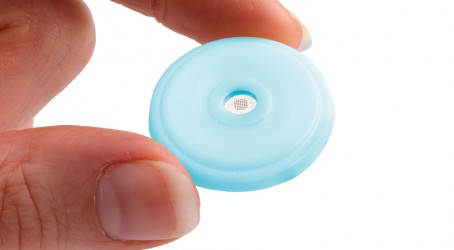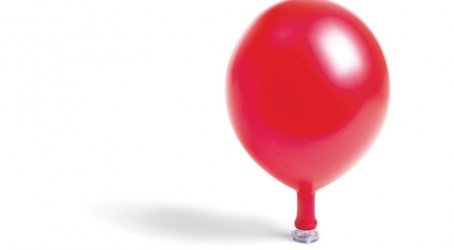How might the hype and expectation about “augmented reality” glasses translate into commercial applications? Well, techno-geeks might prefer their smartphone display projected directly into their field of vision as they walk down the street, enabling them to use a flick of their eye to bring up relevant map details.
Or car mechanics could wear the spectacles while working under a bonnet, giving them instant technical information about any part that they happen to be looking at.
And then there's the medical sector: in the future, a surgeon could lean forward to perform an intricate operation while receiving vital information about the patient's life signs.
All these scenarios are delivered by Allan Carmichael in an impressive burst of mental dexterity. Carmichael works at The Technology Partnership (TTP), the Cambridge-based product development company. He's used to such creative thinking as part of his wider role: augmented reality is just one of many technologies that the scientists and engineers at TTP are progressing.
“Our work is all driven by deep-domain technical skills and the ability to innovate from an engineering perspective,” he says. “Essentially we take an idea and turn it into a product.
“That has led us into many fields. Drug delivery systems, consumer products, desktop instrumentation, digital printers, high-tech sensors – the TTP business is now very diverse.”
Such diversity requires brainpower, and TTP has that in spades. The company employs 300 people, most of whom are scientists or engineers with the requisite business enterprise skills. In recent years, the company has kept something of a deliberate low profile, with discretion often key to what it does. “We offer a contract product development service – and sometimes that means sitting in the background and keeping quiet. Our customers don't always want others to know what we do for them,” he says.
TTP adopts a two-pronged approach to innovation. Sometimes a client comes to it with a specific problem that needs solving. Other times TTP's experts come up with a piece of technology that it then tries to sell through a licence.
With the first method, the start of the innovation process is to sit down with the client to accurately define its problem. “What are they really trying to solve? What's the principal innovation required? These are the sorts of early-stage questions that need answering before we do anything else,” he says.
In the main, that activity is handled through brainstorming sessions, supported by in-depth market research. But other times it requires taking a giant step backwards to see if there is a totally different way of doing things. “We have a sense of confidence in our knowledge and skills, but at the same time we have no baggage from our past as we are not contaminated by having spent a long time in one specific industry. Sometimes that means we see how it is possible to take a completely different approach, looking at the bigger perspective. If you can forgive the cliché, we try to give customers some out-of-the-box opportunities.”
After the initial phase of engagement, TTP tends to follow a fairly well-formulated approach. Further creative sessions come up with several solutions, which are ranked and assessed, putting them in the context of viability, execution, timespan and cost. The next phase is to create a proof-of-concept, to show that conjectures are viable. After that it's about creating a prototype, through to making a more refined product ready for manufacturing. For some companies, TTP's role extends to putting the required supply chain in place.
TTP's second means of developing new products is to identify market opportunities itself. Carmichael says: “Our employees are very commercially focused, despite being engineers and scientists at heart. If we think we have an interesting innovation we will engage with potential customers to see if we have something exciting.
“Then ideally the customer will work in partnership with us, under licence for their specific business need. We retain the intellectual property and the freedom to use the innovation outside of their industry.”

A good example of TTP's innovation is the development of a miniature gas pump that replaces traditional mechanical operation with ultrasonic pressure-generation technology to deliver greatly reduced size and silent running. The patented micro Disc Pump has already been commercialised by one of the firm's customers in a wound therapy application. It is suited to other portable medical applications such as blood-pressure measurement, as well as micro-fluidic and industrial uses where size, noise and controllability are important design factors.
The Disc Pump’s ultra-slim design is achieved by using a piezoelectric actuator to drive pressure oscillations in a thin disc-shaped cavity: one model measures just 4mm in thickness. Silent operation is achieved by running the pump at frequencies above the limit of hearing, using custom, high-speed valves to rectify the pressure oscillations.
TTP says that the combination of pressure-generation technology and high-frequency operation makes it possible to deliver pneumatic performance significantly higher than that of traditional pumps of comparable size. With a wide dynamic range, the firm's technology has already achieved stall pressures in excess of 600mbar and flow rates of more than 2,500cc/min. The high-frequency piezoelectric mechanism provides virtually ripple-free output compared to the pulsed output that characterises most conventional pumps.
James McCrone, head of the group at TTP responsible for micro-devices, says: “We see a growing trend towards miniaturisation, portability and discrete operation in markets such as medical devices, diagnostics and electronics, driving demand for small, silent, high-performance pumps. Responding to this need with an entirely new technology is very exciting as the market is currently dominated by pumps based on mechanical principles dating back over 100 years.”
TTP has already developed a range of designs tailoring performance to specific applications. “We are working with development partners and licensees to take the technology into existing and new markets. The benefits of Disc Pump – backed up by our strong portfolio of patents – help our partners to build a solid market position,” says McCrone.
Other projects have less obvious market potential – but they highlight TTP's innovative nature. The augmented-reality glasses that the firm has been working on, for instance, make it possible to create head-mounted displays that look like conventional glasses and use transparent, curved lenses that do not obstruct the wearer’s field of view.
And, by using simple, low-power, miniature projector optics mounted in the temple arms, there is no need for bulky and unaesthetic frames of the kind that characterised the initial crop of augmented-reality head-up displays and spectacles by companies such as Google.
TTP has also invented a very high-speed switchable fast-focus lens technology that can be used to create what it says is a true 3D experience.
TTP has already demonstrated its patented technology in prototype glasses. The grating optics embedded in the lens could be used for a wide range of optical designs and manufactured at low cost using conventional casting or injection-moulding processes. TTP believes its technology offers hands-free augmented reality for leisure and consumer applications such as ski goggles, running or cycling glasses and interactive gaming. The firm is also exploring uses in military, emergency services, logistics and manufacturing environments.
TTP's Dr Roger Clarke says: “Current head-mounted augmented-reality technologies have drawbacks including flat or darkened lenses, large cumbersome frames and partially or totally obscured fields of view. Our new technology overcomes all of these issues using simple LED-based optics and completely transparent, curved lenses. It opens up a wide range of exciting applications.”
The firm's technology works by projecting light at an angle of 45° towards the lens that contains an embedded grating structure to redirect the light into the eye, as well as performing other optical functions such as astigmatic compensation. The grating structure can be injection moulded, cast or embossed. The structure is then coated with a slightly reflective neutral layer or a bandpass or notched colour filter, depending on the application. The structure is then sandwiched in the lens by the same refractive index material on the other side so there is no change to through-vision in the lens.
The field of view for the augmented-reality display can be varied, while TTP’s very high-speed Switchable Fast Focus lens technology (Swift) can switch the focal length of the lens at up to 1kHz so that different multiple focal plans in a scene can be displayed simultaneously, resulting in a true 3D experience.
TTP is further developing its technology and plans to license it to third parties. The company says that independent research estimates that the market for mobile augmented-reality technology will grow to be worth $3 billion by 2016.
